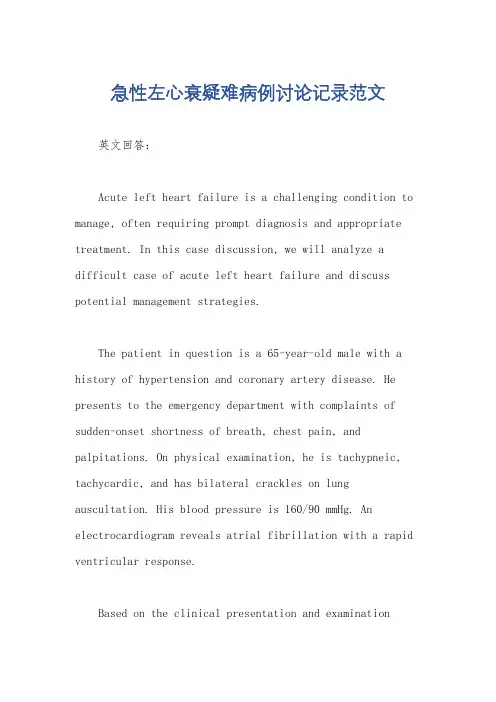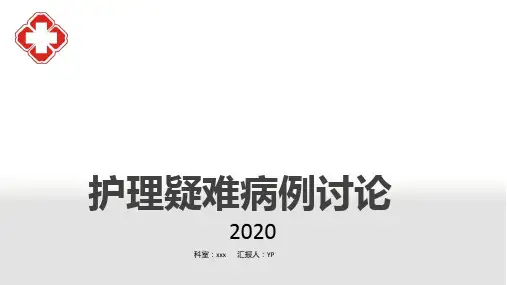急性左心衰护理疑难病例讨论记录范文PPT
- 格式:pptx
- 大小:2.83 MB
- 文档页数:24

急性左心衰疑难病例讨论记录范文英文回答:Acute left heart failure is a challenging condition to manage, often requiring prompt diagnosis and appropriate treatment. In this case discussion, we will analyze a difficult case of acute left heart failure and discuss potential management strategies.The patient in question is a 65-year-old male with a history of hypertension and coronary artery disease. He presents to the emergency department with complaints of sudden-onset shortness of breath, chest pain, and palpitations. On physical examination, he is tachypneic, tachycardic, and has bilateral crackles on lung auscultation. His blood pressure is 160/90 mmHg. An electrocardiogram reveals atrial fibrillation with a rapid ventricular response.Based on the clinical presentation and examinationfindings, the patient is likely experiencing acute left heart failure. This condition is characterized by the inability of the left ventricle to adequately pump blood to meet the body's demands, resulting in fluid accumulation in the lungs and systemic congestion.The first step in managing acute left heart failure is to stabilize the patient's hemodynamic status. This can be achieved by administering supplemental oxygen, diuretics to reduce fluid overload, and vasodilators to decrease systemic vascular resistance. In this case, the patient should be started on continuous positive airway pressure (CPAP) to improve oxygenation and relieve respiratory distress.In addition to stabilizing the patient, it is crucial to identify and treat the underlying cause of acute left heart failure. In this case, the patient's atrialfibrillation is likely contributing to the exacerbation of heart failure symptoms. Therefore, rate control with beta-blockers or calcium channel blockers should be initiated to slow the ventricular response. Anticoagulation therapyshould also be considered to reduce the risk of thromboembolic events associated with atrial fibrillation.Furthermore, it is essential to optimize the patient's volume status and manage any comorbidities that may be worsening heart failure. Close monitoring of fluid intake and output, as well as daily weights, can help guidediuretic therapy. Renal function should be closelymonitored to prevent worsening kidney injury due todiuretic use.In summary, the management of acute left heart failure involves stabilizing the patient's hemodynamic status, treating the underlying cause, and optimizing volume status. Prompt diagnosis and appropriate treatment are crucial in improving outcomes for patients with this condition.中文回答:急性左心衰竭是一种难以处理的疾病,通常需要及时诊断和适当治疗。


